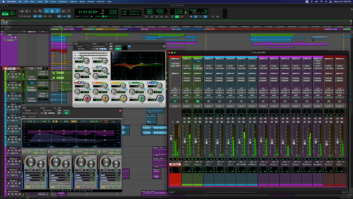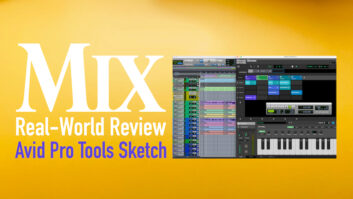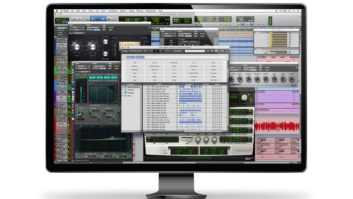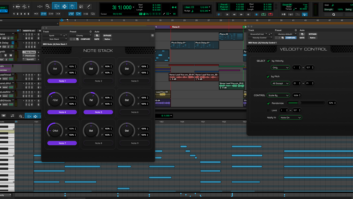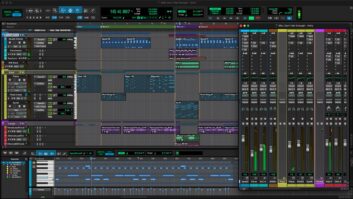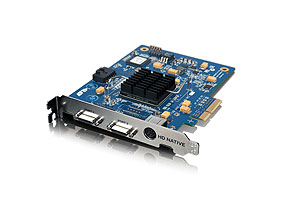
The Pro Tools|HD Native PCIe card can be purchased by itself or in a hardware I/O bundle.
There is no question that Pro Tools 9 has been one of the most significant releases of the popular software to date. Long-standing barriers have been broken down, ushering in a new era. Opening up to third-party hardware and unlocking features like the timecode ruler, automatic delay compensation and DigiTranslator in all tiers of the software has, indeed, invited a new school of users. Now, with the release of Pro Tools|HD Native, Avid offers a new and affordable way to use its high-end I/O, including the HD Omni (reviewed here), while promising super-low latency. Pro Tools|HD Native can be purchased with just the PCIe card and software, or as a bundle. (Various bundle pricing at Avid.com.)
LATENT TENDENCIES
What many native DAW users, especially those using USB or FireWire interfaces, don’t realize is that Pro Tools|HD does a much better job of managing latency than most other DAWs. Anyone who has ever crashed and burned while tracking vocals because the artist couldn’t get over the weird delay in the headphones knows what I’m talking about.

Pro Tools HD Native includes a software mixer incorporated into the Hardware Setups window.
The A/D converters in most devices, at best, work only slightly slower than real time. From there, the USB and FireWire buses fail to be the speediest protocols to deliver data, and when you add in the other passengers riding that same line, transit becomes even slower. Once that data gets to your computer, it has to talk to an audio driver, which will address the data in a way that is meaningful to audio software running within your operating system. This seems to be one of the most substantial lags, considering that the same processor is dealing with audio, graphics, video, network transmissions and anything else that’s happening in the OS. In some systems, audio will take a back seat to other processes to accommodate, for example, a networked transmission from your control surface. Finally, there’s the one factor we can control—the playback buffer—which, depending on the size of your session, can be set to a wide range of durations. A safety offset ensures that even if the buffer is overrun, the DAC, which also slows things down, can perform correctly.
LICKING LATENCY
Avid has addressed I/O latency in Pro Tools|HD Native with three levels of defense. The primary means is simple: Keep your buffers low, do nothing differently than you would on a typical HD system, and everything will be okay. Bumping up the buffers beyond 64 samples on a 24-bit/48kHz Pro Tools session was rarely necessary. I opened up a 5.1 mix for a 16-minute short film. The session used 147 voices, more than 100 tracks, dozens of plug-ins and automation, not to mention the compressed video clip. I kept backing off settings in the playback engine to see how low I could go. With H/W Buffer Size set to a mere 32 samples, running four processors at 85-percent CPU usage, I could still keep my disk buffer at the lowest setting and play back without error. On top of that, I was able to overdub a vocal; due to the scaled-back settings in the playback engine, no noticeable latency was incurred in the headphones. Shocking!
Next, I opened up a 24-bit/44.1kHz music mix, with the intent to overdub an electric guitar solo. This was a session with high-delay-inducing Drumagog plug-ins running alongside a dense mix incorporating other plug-in processors. Stir in the necessary delay-compensation engine, and a bigger buffer became a bit more necessary. Even when increasing the buffer to 256 samples, I was really surprised with how unnoticeable the latency remained. Conversely, a 256 sample buffer on a Pro Tools system running off of the CoreAudio driver is uncomfortably apparent. Due to the low latency of the PCIe-based HD Native architecture streaming through its dedicated audio driver, even a vocal mic recorded in a session buffered at 512 samples fell just shy of that awkward latent feeling. I even tracked a vocalist who had complained about delay in the cans in the past, kicked the buffer up to 1,024 samples just to see what would happen, and she really didn’t hear a delay until I made her listen for it.
Avid’s second solution is the inclusion of a software mixer incorporated into the Hardware Setups window. To me, this is a baby-step in the right direction. I have an M-Audio Fast Track Ultra. It has a similar software mixer available through the Mac System Preferences window. Using this device with Pro Tools M-Powered 7 and beyond, I could go to the Hardware Setups window in Pro Tools for a link to that software mixer. The only difference between that and what is offered in HD Native is that rather than linking to a different window, the mixer lives “inside” the Pro Tools software. If it were found in the Mix window, even as a pulldown tab like the “Tracks” or “Groups” on the left, that would be far more practical. It is a very practical way to manage zero-latency monitoring, as proven by countless devices that use this solution. But you’re always taking a trip to the Hardware Setups, which has no quick key to access it, and paging over to the fourth tab in that window is cumbersome.

LOW-LATENCY MONITORING PATH
One concern of low-latency workflow comes into play when performing punches. If an artist is listening directly to the input of the track in which they are recording, usually that track is muted to avoid hearing the latent double. If the track is muted, they can’t hear playback up to the point of the punch. Though there are workarounds to this, Avid attempts to afford a more elegant solution to this problem, dubbed the “LLM Path” for Low-Latency Monitoring. This provides a way to toggle a track between playback and zero-latency input monitoring automatically at the point of a punch.
Deeply integrated into the DAW, this is an option that requires defining a hardware output path to be dedicated to this function in the I/O Setups window. From there, an input-ready track’s output is routed exclusively to that path, at which point the entire operation of that track is redefined. While other tracks will be buffered and delay-compensated according to the Playback Engine settings, tracks in LLM mode avoid any buffering before output. When other playback tracks are sent via aux sends to the Cue path dedicated to LLM, they are pre-buffered and playback is relatively synchronized to the LLM track being recorded. This way, the artist hears all of the bed tracks playing normally, and hears their own overdub mixed with those tracks free of delay.
Using this function with the new HD Omni, I had mixed feelings. An annoying stipulation was that LLM couldn’t be configured if surround paths existed in the I/O setups. The other concern you may face is that there is only one LLM path configurable; you can provide one zero-latency monitor path for your artist(s). This left little to complain about for me, as the HD Omni only has one headphone jack and is designed to accommodate this feature quite harmoniously. Near the control room level/headphone level control is a Cue button, which accesses a path set up in the I/O Setups specifically designed to be an artist headphone mix. When designating this as the LLM path, it’s easy to feed the artist the latency-compensated mix at the touch of a button. The awkward part is that a track in LLM mode cannot also feed the main control room output path. As a result, while the artist hears an LLM mix through the headphones, you must also create an aux input to monitor his/her input signal through the buffered, delay-compensated mixer feeding the control room output. It was bearable, but I found it a bit clunky.
As the LLM track is not passing through the Pro Tools mixer, the artist cannot monitor plug-ins inserted on the record-enabled track, supposedly. I found that plug-ins on the LLM track reflected a bypassed status, but still passed their processing through to the CUE output. Ultimately, it seems that LLM was designed as a solution to be used in a pinch when a giant sluggish session needs a last-minute overdub. Fortunately, that was the case because until I really got the hang of it, I found it to present more confusion than convenience.
THE HD OMNI
Altogether, the HD Omni was an impressive, new direction for HD hardware design. In general, the overall sound of the ADC and DAC are leap-and-bound improvements from the early 96 I/O and 192 I/O. There is a much greater sense of realism there than I’m used to hearing with Avid hardware, suggesting a much greater accuracy in clocking. The inputs’ analog technology also surpassed the expectations put into place by devices like the C|24. There is a bit more color than seen before, most evident in a fatter bottom end but without compromised detail in the top. The instrument inputs exhibit the same analog technology as the Eleven Rack. Properly structuring input impedance to make a guitar truly sound like it’s plugged into an amp when feeding an emulator plug-in is rarely executed with the authenticity I heard here. I also really dug the input limiter settings. Either a soft clip or soft-knee limiter are selectable pre-digital conversion, allowing for your choice of a more transparent clip protection or a more aggressive and musical, analog smack. Both sounded great for their individual purposes.
The monitoring section performed all of the needs of a stereo control room admirably. Its function as a surround monitor controller, on the other hand, was a bit disappointing. Pleasant features included output calibration settings like individual output trims for each speaker, settings to designate hardware outputs as +10dBu feeds direct to powered monitors or +24dBu line-level outputs to other devices, and an SPL-based display. Front panel metering displayed the output order designated by your routing configuration. Management of settings available through Hardware Setups could also be accessed through the front panel when using the hardware in the absence of Pro Tools.
Downmixing provided little user control, however. I’m still unclear as to what is happening if a fold-down setting is applied to a 5.1 output downmixed to stereo. The term “fold down,” in my experience, usually implies matrix encoding, and based on my tests it seems that this might be what’s happening as the phase relationship of the surrounds summed to the fronts seemed altered. I’d appreciate some mention of specifics in the documentation. Avid suggests purchasing software such as Neyrinck SoundCode downmixer. I find it interesting that Neyrinck has provided Avid with a SoundCode Stereo downmix plug-in that is included in the CPTK2, and that plug-in is exclusive to that package. Given that Pro Tools 9 with CPTK2 is supposed to be one step down from HD Native, it seems that this plug-in would be included with HD Native or the HD Omni. Instead, a similar, but more fully featured version can be purchased separately from Neyrinck for $350.
Finally, the entire design suggests that this is a device meant to be right in front of the engineer, who is critically listening to their monitors. It’s also pretty apparent that the design accounts for a singer being nearby when cutting vocals with a mic and headphones plugged into the front panel jack. Neither of these goals seem hardly practical in the presence of the overwhelming fan noise exuded by the HD Omni. Even with headphones on, it drones and whirs at a very apparent loudness level. Many vocals I tracked in the same room as the HD Omni were unusable because of the noise. The included literature states that the device must stay cool and to avoid racking it, use a solution where the sides are covered. This is an issue that should be addressed.
IS THIS THE END OF HD?
While many are looking at Pro Tools|HD Native as an admission of defeat, or a first step toward studios stepping down from HD systems, I hardly see it as that. Full-blown HD systems will continue to be the backbone of the film mixing and high-end recording industries with no foreseeable end in sight. Meanwhile, it’s clear that Avid realizes that stripping features wasn’t keeping people buying Pro Tools|HD, it was just forcing them to turn to other pieces of software. In between, there have always been rock-solid professionals who appreciate the role of HD systems and have continued to buy them for the right reasons. When looking for a powerful system that can be trusted day in and out, providing plenty of I/O and low latency, Pro Tools|HD has always been a no-brainer. Pro Tools|HD Native recognizes that with the powerful computers of today, this same level of reliability can be accomplished at a lower overall cost by maintaining what is really important and removing what is not. The PCIe-based throughput, employing a proprietary audio driver, gets the job done with or without the additional DSP provided by traditional HD core cards. The end result is that the prestige of Pro Tools|HD is now more affordable than before.
Brandon Hickey is a freelance engineer and audio educator.

Click on the Product Summary box above to view the Pro Tools|HD Native product page.
